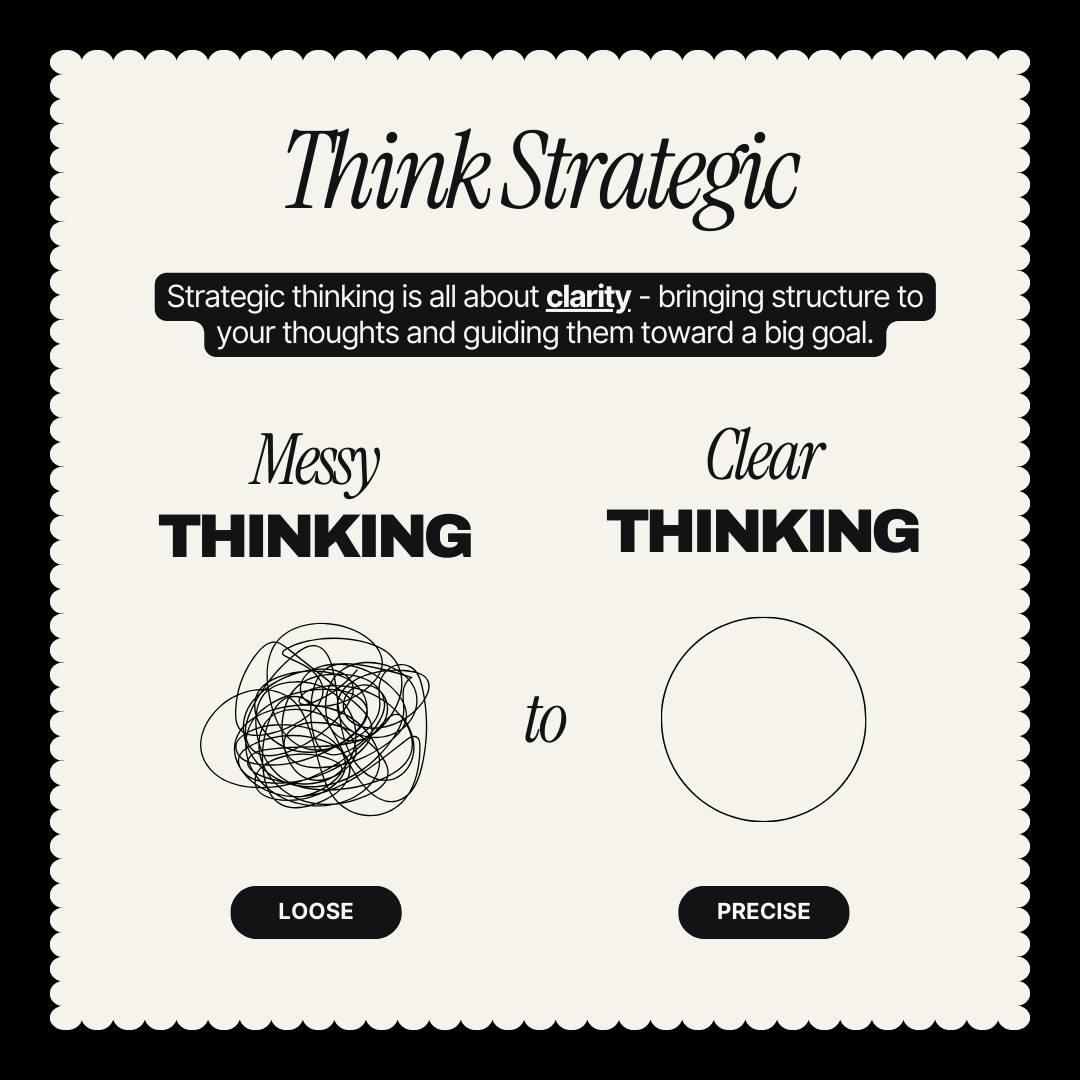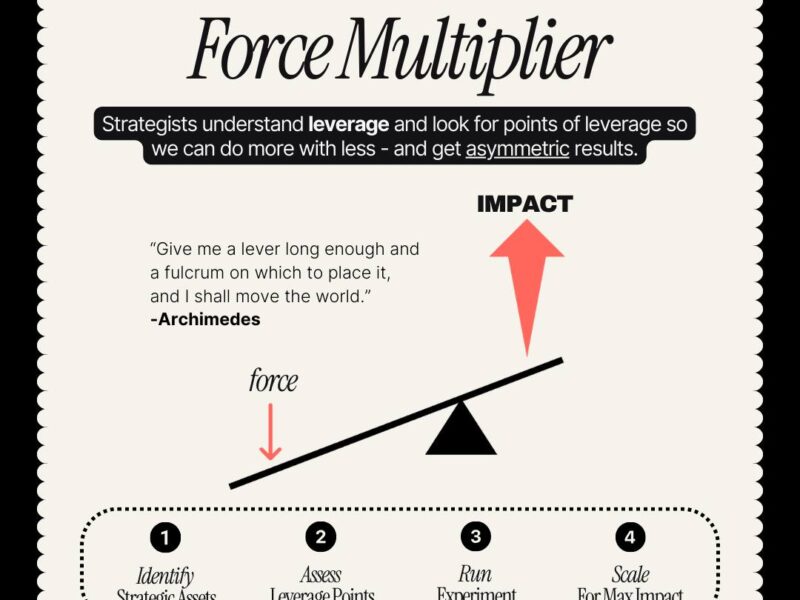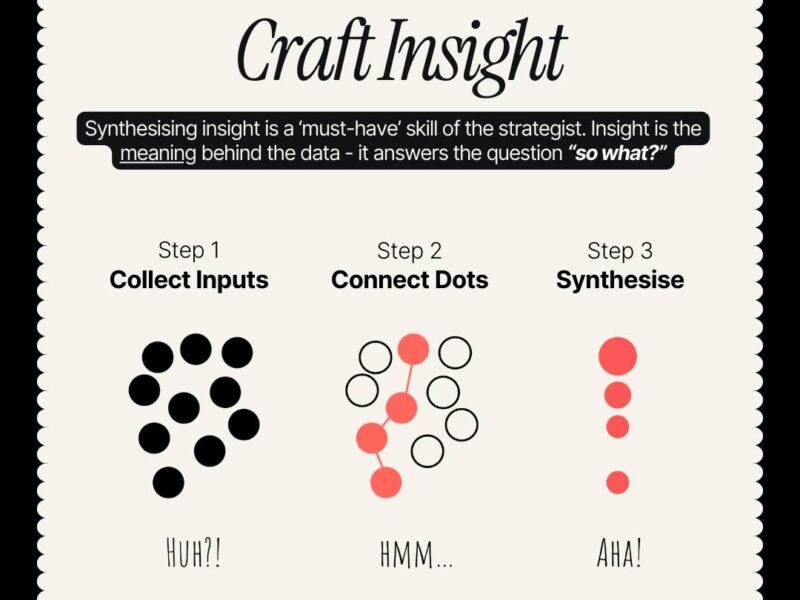From Chaotic Juggling to a Clear Path Forward
As a UX Designer and IT Solutions Architect with over two decades in the trenches, I’ve witnessed a fundamental truth: the single greatest determinant of a project’s success or failure isn’t the technology chosen, but the quality of the thinking that guides it. I’ve seen brilliant ideas with messy execution die in a whirlwind of scope creep, while simple ideas, backed by crystalline strategic thinking, achieve remarkable outcomes.
The image we’re discussing today perfectly captures this dichotomy. It presents a powerful visual metaphor: the chaotic, tangled knot of “Messy Thinking” versus the direct, purposeful arrow of “Clear Thinking.” This isn’t just a philosophical idea; it’s a practical framework for anyone building products, services, or businesses in our complex digital age.
Strategic thinking, as the image states, is the discipline of bringing structure to your thoughts and guiding them toward a big goal. It’s the process of moving from LOOSE to PRECISE. In this article, we will dissect this transition, explore its profound implications for user experience and technology architecture, and provide you with the tools, frameworks, and mindset to make strategic thinking your default mode of operation.
The High Cost of Messy Thinking
Messy thinking feels like juggling too many thoughts at once. It’s the state of being perpetually reactive, where your inbox, the latest urgent request, or the loudest stakeholder dictates your priorities. In the context of UX and IT, this is a recipe for disaster.
Characteristics of Messy Thinking:
Scattered Ideas: This manifests as a product backlog that resembles a wish list from a committee with conflicting goals. Features are added ad-hoc without a unifying vision. For a UX designer, it means designing screens in isolation, without a coherent user flow or consistent design system. For an architect, it means making technology decisions based on short-term convenience rather than long-term scalability.
Reacting to Everything: This is the “shiny object” syndrome. A competitor releases a new feature, and there’s a panic to replicate it without asking why it serves their strategy or, more importantly, if it serves ours. It leads to a fragmented user experience and a bloated, unstable codebase.
Short-term Focus: Fixing the immediate bug without addressing the underlying architectural debt. Prioritizing a quick launch over a validated, user-centric solution. This approach incurs a “thinking debt” that compounds over time, making future progress slower and more expensive.
Overwhelmed by Details: Getting lost in the weeds of pixel-perfect alignment on a single screen while ignoring the broken user journey that leads to it. Or, for an architect, obsessing over the specific syntax of a code function while missing a fundamental flaw in the system’s data model.
The outcome of messy thinking is predictable: wasted resources, frustrated teams, and ultimately, products that fail to resonate with users. A study by the Project Management Institute (PMI) consistently finds that a lack of clear goals and objectives is a primary contributor to project failure [Reference 1: PMI’s Pulse of the Profession Reports].
The Power and Clarity of Strategic Thinking
Clear thinking, in contrast, feels like walking down a straight path. It’s focused, organised, and intentional. You have a map. You know your destination, and you can navigate obstacles because you understand why you’re taking the journey in the first place.
Characteristics of Clear Thinking:
Organised Thoughts: Ideas are structured hierarchically. The primary business objective is supported by key results, which are achieved through specific initiatives, which are broken down into actionable tasks. In UX, this means a well-defined information architecture, user journeys mapped to specific goals, and a design system that ensures consistency and efficiency.
Purposeful Responses: Instead of reacting, you respond. A competitor’s new feature becomes a catalyst for a strategic discussion: “Does this align with our core value proposition? What user problem are they solving? Is there a better way for us to solve our users’ problems?” This mindset fosters innovation rather than imitation.
Long-term Vision: Strategic thinking forces you to lift your gaze from the immediate task to the horizon. What do we want this product to become in three years? How will this technology decision affect our ability to adapt in five years? This vision acts as a compass, ensuring that short-term tactics align with long-term ambitions.
Sees the Big Picture: This is the systems thinking perspective. A UX designer with clear thinking understands how a single button change affects the backend logic, the customer support load, and the user’s emotional journey. An architect sees how a new microservice interacts with legacy systems, data governance policies, and security protocols.
The payoff is immense. Clear thinking leads to efficient development, cohesive user experiences, higher team morale, and products that genuinely meet user and business needs. As the image wisely states, “Ideas articulated clearly win hearts and minds.” This is true for persuading stakeholders, guiding your team, and, most importantly, connecting with your users.
The Strategic Shift: From Messy to Clear
How do we consciously make this shift? It requires a deliberate practice of asking the right questions, maintaining relentless curiosity, and maintaining an unwavering focus on outcomes. This is where theory meets practice. Let’s break it down into a actionable process.
Necessary Inputs: The Fuel for Strategic Thought
You cannot think strategically in a vacuum. You need high-quality raw materials.
User Research: This is non-negotiable. Strategic clarity in UX begins with a deep, empathetic understanding of your users. Inputs include:
User Interviews: Qualitative insights into motivations, pain points, and behaviors.
Analytics Data: Quantitative data on how users are actually interacting with your product (e.g., Google Analytics, Amplitude, Mixpanel).
Surveys: Broader quantitative data on user satisfaction and demographics.
Competitive Analysis: Understanding the landscape in which your product exists.
Business Context: A product must serve a business goal. Inputs include:
Business Objectives and Key Results (OKRs): What is the company trying to achieve this quarter/year?
Stakeholder Interviews: Understanding the perspectives, constraints, and goals of key people across the organization (e.g., marketing, sales, support).
Technical Constraints: An honest assessment of current system capabilities, legacy debt, and team skills.
Frameworks and Tools: The Engine for Structuring Thought
These are the practical instruments that transform messy inputs into clear, structured plans.
1. The Double Diamond Framework (Design Council)
A seminal framework that perfectly illustrates the strategic process of moving from loose to precise. [Reference 2: Design Council – The Double Diamond]
Discover (First Diamond – Divergent Thinking): This is about embracing the “loose” and the messy. You are conducting research, gathering all possible information, and exploring the problem space broadly without judgment.
Define (First Diamond – Convergent Thinking): Here, you synthesize your research to form a precise problem statement. You move from many possibilities to a single, well-defined core problem to solve. This is a critical shift from loose to precise.
Develop (Second Diamond – Divergent Thinking): With a clear problem defined, you now brainstorm a wide range of potential solutions. This is another phase of loose, creative exploration.
Deliver (Second Diamond – Convergent Thinking): You prototype, test, and iterate on the best solutions, refining them until you arrive at a final, precise solution that is ready to launch.
Tool: Miro or Mural boards are excellent for visually mapping out each stage of the Double Diamond with your team.
2. Jobs to be Done (JTBD)
This framework moves you beyond demographics and into user motivation. The core idea is that users “hire” products to get a specific “job” done. [Reference 3: Harvard Business Review – Knowing Your Customers’ “Jobs to Be Done”]
Application: Instead of thinking “we need to build a feature for millennials,” strategic thinking asks, “What is the fundamental progress a user is trying to make in a given situation?” Framing features around a Job Story (“When I ___, I want to ___, so I can ___”) brings incredible clarity and purpose to design and development.
3. Wardley Maps
For IT Solutions Architects, Wardley Mapping is a powerful tool for strategic clarity. It allows you to map the components of your service based on their evolution in the market (from genesis to commodity) and their value chain. [Reference 4: Simon Wardley – Wardley Maps]
Application: A Wardley Map visually reveals which components are strategic differentiators (where you should innovate) and which are utility costs (where you should use standard, efficient solutions). This prevents wasteful investment in reinventing the wheel and focuses innovation where it matters most.
4. Impact Mapping
This is a strategic planning technique that connects goals to deliverables. It creates a clear, visual roadmap that ensures every activity is tied to a business objective. [Reference 5: Impact Mapping.org]
Structure:
Goal: Why are we doing this? (The big, strategic goal)
Actors: Who can help us achieve this goal? (Users, partners, etc.)
Impacts: How should the actors’ behavior change?
Deliverables: What can we do to support those changes? (Features, projects)
This tool is exceptionally effective at cutting through feature bloat and aligning teams around outcomes, not outputs.
Expected Outputs: The Tangible Artifacts of Clarity
The process of applying these frameworks results in concrete, shareable artifacts that become the source of truth for the entire team.
From Messy Inputs to a Precise Problem Statement: A one-sentence summary that everyone agrees on. (e.g., “New freelance designers need a way to easily create legally-binding contracts because they cannot afford expensive lawyers and are afraid of making costly mistakes.”)
User Journey Maps: Visual narratives that illustrate the user’s end-to-end experience, highlighting pain points and opportunities. (Tool: UXPressia, Smaply)
Structured Roadmaps: Not just a list of features, but a timeline of initiatives linked to strategic goals and key results. (Tool: Aha!, Productboard, or a simple spreadsheet).
System Architecture Diagrams: Clear, layered diagrams that show how different components of the technology stack interact to support the user experience and business goals. (Tool: Lucidchart, Draw.io).
Best Practices for the Strategic Thinker
Timebox Your Thinking: Strategic thinking can become procrastination if not constrained. Use timeboxing for brainstorming and research phases. For example, “We have one week for initial discovery research.”
Embrace “Good Enough” Data: Paralysis by analysis is a symptom of messy thinking. You will never have perfect information. Make the best decision you can with the data available, and validate it through experimentation.
Communicate Visually: As the original image shows, a simple visual can convey what a thousand words cannot. Use diagrams, maps, and sketches to articulate your strategic ideas.
Create a Culture of “Why?”: Foster an environment where team members at all levels are encouraged to ask “Why are we building this?” This simple question is the ultimate antidote to reactive, messy work.
Iterate on the Strategy Itself: Strategy is not a one-time event. The market changes, user needs evolve, and new technologies emerge. Schedule regular “strategy check-ins” to ensure your clear path is still leading to the right destination.
Conclusion: Your Journey to Strategic Clarity
The journey from messy to clear thinking is a discipline. It’s a commitment to moving beyond the comfortable chaos of reaction and into the disciplined clarity of purpose. It’s the difference between juggling blindly and walking purposefully toward a known destination.
As a UX professional or technology architect, your highest-value contribution is not the wireframe you draw or the code you write, but the strategic clarity you bring to the process. You are the translator of ambiguity into action. By leveraging the right inputs, frameworks, and tools, you can consistently articulate clear ideas that win the hearts and minds of users, stakeholders, and your team, turning a tangled knot of possibilities into a straight path to success.
Start today. Pick one current project. Step back and ask the fundamental strategic questions: What is the core problem we are solving? For whom? What does success look like in the long term? The answers will be the first step on your straight path forward.
References:
Project Management Institute (PMI). Pulse of the Profession Reports. https://www.pmi.org/learning/thought-leadership/pulse
Design Council. The Double Diamond. https://www.designcouncil.org.uk/our-work/skills-learning/tools-frameworks/the-double-diamond/
Christensen, Clayton M., et al. Knowing Your Customers’ “Jobs to Be Done”. Harvard Business Review. https://hbr.org/2016/09/knowing-your-customers-jobs-to-be-done
Wardley, Simon. Wardley Maps. https://wardleymaps.com/
Impact Mapping. Introduction to Impact Mapping. https://www.impactmapping.org/
Additional Tools Mentioned:
Collaboration & Diagramming: Miro, Mural, Lucidchart, Draw.io
User Research & Journey Mapping: UXPressia, Smaply
Product Management: Aha!, Productboard
Analytics: Google Analytics, Amplitude, Mixpanel
Image belongs to: Overnight Strategist.


